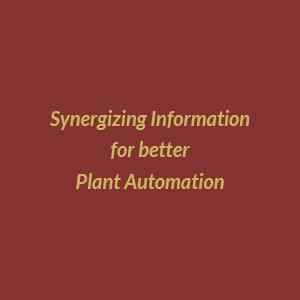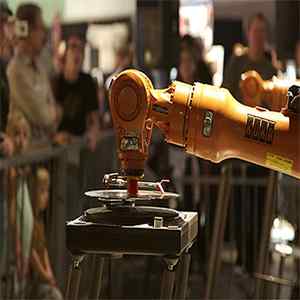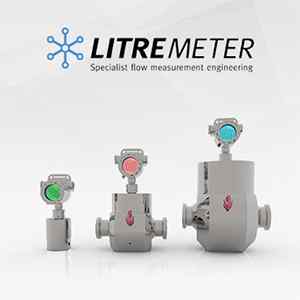Articles
An Overview of Programmable Logic Controllers (PLC)
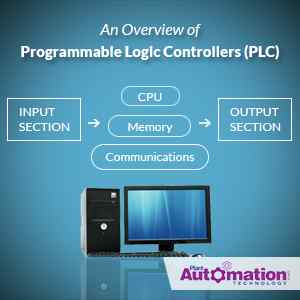
Programmable Logic Controllers (PLCs) have been used in the automation market for more than 40 years. Still, the global PLC market is showcasing the remarkable growth since 2016.
In addition, the latest advancements in PLCs have greatly increased their capabilities in industrial automation solutions. Due to its advanced automation handling capabilities, the introduction of PLCs has been aiding the market in terms of better operability.
PLC Market - Overview
The changing industrial landscape of emerging economies such as India, Brazil, Indonesia, and Mexico are stimulating the adoption of PLCs. The increasing demand for industrial control systems in the automation, manufacturing and construction industries will fuel the demand in the global market.
On the other hand, the PLC market (programmable logic controllers market) is projected to reach revenues of more than $46 billion by 2022 and is estimated to grow at a CAGR of over 8% during the forecast period.

PLC Market – Dynamics
The growing prominence of PAC (Programmable Automation Controllers) and PLC-based PACs is attributing to the growth of the PLC market. According to Technavio’s market research report, the demand for PLCs will grow at a steady rate and the growing need, popularity of customized PLCs will drive the growth prospects.
In the manufacturing industries, there is an increasing demand for customized PLC programming solutions that help industries design their own controller package for small, medium, or large machines. On the other hand, customized PLCs provide solutions for demanding industrial environment, and process complexity and also offer automation solutions such as system reliability, system stability, and interoperability, which will fuel the adoption of PLCs in the coming years.
Introduction to PLC:
PLC (Programmable Logic Controller)
The National Electrical Manufacturers Association (NEMA) defines PLC as a “
Digitally operating electronic apparatus which uses a programmable memory for the internal storage of instructions by implementing specific functions, such as logic, sequencing, timing, counting, and arithmetic to control through digital or analog I/O modules various types of machines or processes.”
Programmable Logic Controller (PLC) is a ruggedized digital computer which is used for industrial automation to carry out typical industrial electromechanical processes such as control of machinery on factory assembly lines, amusement rides, or light fixtures. These controllers help to automate a specific process, machine function, or even an entire production line.
They are specifically designed for multiple arrangements of digital, analog inputs and outputs, extended temperature ranges, immunity to electrical noise, and resistance to vibration and impact. The major purpose of PLCs is to monitor crucial process parameters and adjust process operations accordingly. PLCs are extensively used as they are easy to set up a program, and they are ruggedized.
Components in a PLC system
• CPU module, containing the processor and memory
• Input and output modules, to allow the PLC to read sensors and control actuators
– A wide variety of types are available
• Power supply for the PLC, and often sensors and low power actuators connected to I/O modules
• A rack or bus so the PLC can exchange data with I/O modules
A Programming unit which is used to create; edit and download a user program to the PLC
• Additional components can include:
– Network interfaces: to allow PLCs to function in a networked environment
– Communication adapters for remote I/O devices: so I/O devices do not have to be physically close to the CPU module
– Operator interface devices: allow monitoring and/or data entry by operators
Working of PLC:
The PLC obtains information from connected sensors/input devices and then processes the data, and triggers outputs based on pre-programmed parameters. PLC can monitor and record run-time data such as machine productivity or operating temperature, depending on the inputs and outputs.
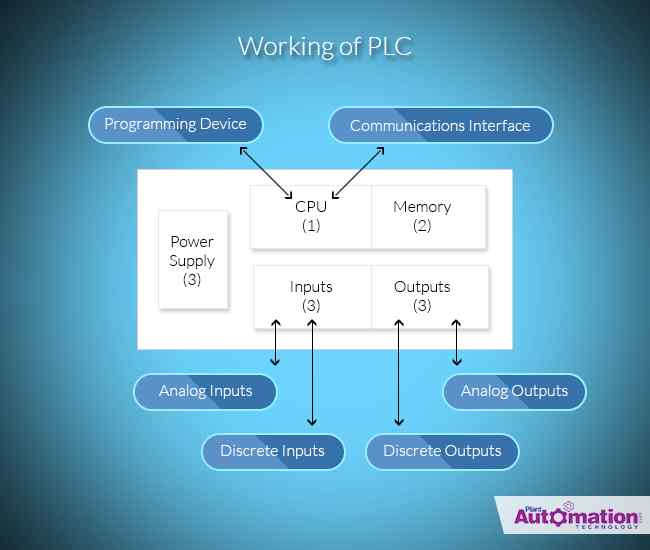
Figure: Block Diagram of PLC
It starts and stops processes automatically and generates alarms if a machine malfunctions. Programmable Logic Controllers are a flexible and robust control solution that is adaptable to almost any application.
The components that make a PLC to work efficiently can be divided into three core areas.
• The power supply and rack
• The central processing unit (CPU)
• The input/output (I/O) section
The working of PLC includes sequential relay control, motion control, process control, distributed control systems, and networking. The most basic function of a programmable logic controller is to follow the functions of electromechanical relays. Separate inputs are given a unique address, and a PLC instruction is tested whether the input state is ‘on’ or ‘off’.
In automation, TRUE or FALSE conditions can be considered as ON or OFF, CLOSED or OPEN. In the PLC, we will consider binary system (0 or 1).
Typically, having a bit ON represents a TRUE condition while OFF is FALSE.
The AND function
The AND gate is associated with the following symbol that can have any number of inputs but only one output.

The truth table below shows that the output is only turned on when all the inputs are true (1). In other words, AND works like multiplication.
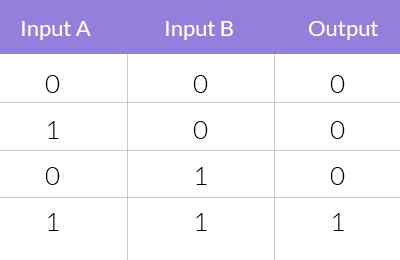
The ladder logic equivalent for an AND function looks like two normal contacts side by side.

The OR function
The OR gate is associated with the following symbol that also can have any number of inputs but only one output.

The truth table below shows that the output is turned on (1) when any of the inputs are true (1). In other words, OR works like addition.
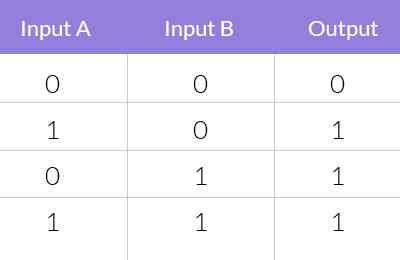
The ladder logic equivalent to an OR function looks like two normal contacts on top of each other.
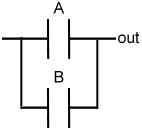
A Logical AND function performs a series of relay contacts, not allowing the current to pass unless all the contacts are closed. The output storage bit will be energized when a series of ‘examine if on’ instructions are performed and if all the input bits are on.
Similarly, a logical OR function will be performed by a parallel set of instructions. A group of contacts controlling one coil is called a ‘rung’ of a ‘ladder diagram’. This concept is used to describe PLC logic. The output of each rung sets clears a storage bit. This may be associated with a physical output address. More advanced instructions of the PLC may be implemented as functional blocks, which carry out some operation when enabled by a logical input and which produce outputs to signal.
Applications of PLC:
PLCs are used in various places of automation because of its flexibility. As humans feel tedious to carry out all the tasks, relays were used to perform those activities. However, a relay can be used only for a specific and limited operation which makes their use bulky and uneconomic.
PLCs can be used in various applications:
- Robotic arm in car manufacturing
- Air compressors
- Airport runway lighting control
- Traffic signal control
- Smoke alarm control
- Process valve control
- Textile equipments
- Vacuum pump system
Advantages/Disadvantages of PLC:
Advantages of PLC are:
Flexibility: It can an easily run many machines
Corrects Errors: With PLC control any change in circuit design or sequence is as simple as retyping the logic. Correcting errors in PLC is extremely short and cost effective.
Space Efficient: We can generate more & more contacts, coils, timers, counters, sequences etc and we can have thousands of contact timers and counters in a single PLC.
Low Cost: Prices of Programmable Logic Controllers vary from few hundreds to few thousands.
Testing: A Programmable Logic Control program can be tested and evaluated in a lab. The program can be tested, validated and corrected saving very valuable time.
Easier Troubleshooting: Troubleshooting a circuit is really quick, easy and simple.
Disadvantages of PLC are:
• It is difficult to find errors and require skillful work-force to operate.
• When a problem occurs, hold-up time is indefinite, usually long.
• There will be too much work required in connecting wires
• There will be difficulty with changes or replacements
Types of PLC:
PLCs are integrated as either single or modular units. The types of PLCs are:
• An integrated or Compact PLC
• A modular PLC
Small PLC
Medium-sized PLC
Large PLCs
Integrated or Compact PLC:
It is built with several modules within a single case. Therefore, the I/O capabilities are decided by the manufacturer. Some of the integrated PLCs allow to connect additional I/Os to make them somewhat modular.
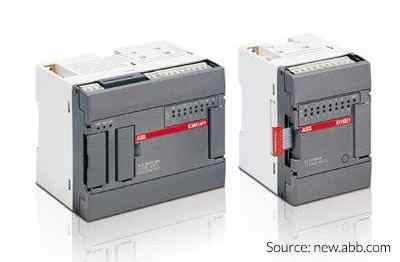
Figure: Integrated or Compact PLC
Modular PLC:
Modular PLC is built with several components that are plugged into a common rack or bus with extendable I/O capabilities. It contains power supply module, CPU and other I/O modules that are plugged together in the same rack. These modular PLCs come in different sizes with variable power supply, computing capabilities, I/O connectivity, etc.
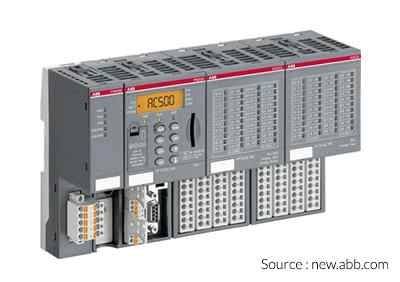
Figure: Modular PLC
Modular PLCs are further divided into small, medium and large PLCs based on the program memory size and the number of I/O features.
Small PLC:
It is a mini-sized PLC that is designed as compact and robust unit mounted or placed beside the equipment to be controlled. It can be used for replacing hard-wired relay logics, counters, timers etc. It uses logic instruction list or relay language as programming language.
Medium-sized PLC:
Medium-sized PLC is mostly used PLC in industries as it allows may plug-in modules that are mounted on black plane of the system. Communication module facilities, input/outputs are provided by adding additional I/O cards.
Large PLCs:
Large PLCs are used when complex process control functions are required. These PLCs’ capacities are quite higher than the medium PLCs in terms of memory, programming languages, I/O points, and communication modules, and so on.
These PLCs are used in supervisory control and data acquisition (SCADA) systems, larger plants, distributed control systems, etc.
Interlocking in PLC:
Programming in PLC is done using Ladder logic or other formats. There are various terms that are used in programming to identify how they will interact with other system:
These terms include:-
• Permissives
• Protections
• Interlocks
Permissives: They are minimum perquisites that are required for drive or system to operate. Like lubrication system should be on before a drive starts etc.
Protections: They prevent a drive/logic from a harmful condition and stop system to prevent human or mechanical damage.
Interlocks: They are code or conditions that are executed when another action happens and change how the drive/code was working to provide a smooth running process.
In other words, Interlocks are often used to start auxiliary equipment, standby drives, or to prevent starting of systems for smooth operations.
Example: If two mortars (say motor A & Motor B). Say, if one motor is used generally but necessary 24 X 7. Then adding an interlock in logic of motor A because if the other motor B turns off due to error then start drive A.
A key note is that Interlocks will require permissives to be followed, i.e. only interlock is not sufficient, permissives are also to be met. Interlocks provide some ease in operation and reduce human errors.
Interlocking:
In the PLC program, it is an action to control the process when certain conditions occur i.e. temperature exceeding its limit, flow below requirement or any parameter exceeding beyond its safe operating limits.
Importance of PLC:
The importance of PLC in automation is:
• PLC is used in the fully automated industries. The actual processes handled and controlled by the controllers mean that PLC plays a very important role in automation section.
• PLCs constantly monitor the state of the systems through input devices and generate the control actions according to the logic given in the user program.
• It is a heart of control systems, PLC monitors the state of the system through field input devices, feedback signals and based on the feedback signal PLC determine the type of action to be carried out at field output devices.
• It provides logic / sequence control.
Overall, PLC has a great impact on automation industry in controlling the devices and programming logically. It is mainly designed for multiple inputs and output arrangements and it can withstand extreme temperatures with resistance to vibration and impact.




